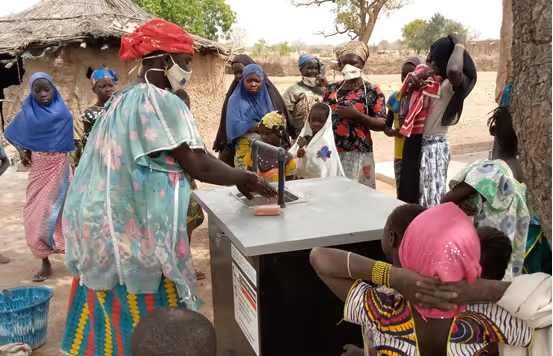Simplified family Mid Upper Arm Circumference (MUAC) integrated nutrition program in Taiz

Project overview
This project piloted caregiver-led screening for malnutrition in Yemen using uniMUAC bracelets, enabling early identification and referral of Severe Acute Malnutrition (SAM) cases in crisis-affected communities.
Project solution
This project offers [specific solution or intervention] to tackle [challenge]. By implementing [strategies, tools, or innovations], the project aims to achieve [desired outcomes]. The approach is designed to [specific actions or methods] to bring about meaningful change in [community, region, or issue area].
Expected outcomes
This project aims to achieve [specific outcomes], such as [measurable results, improvements, or changes]. The expected impact includes [benefits to the target community, advancements in research or innovation, or long-term effects]. By the end of the project, we anticipate [specific changes or milestones] that will contribute to [broader goals or objectives].
WHAT HUMANITARIAN NEED IS BEING ADDRESSED?
The project addressed high rates of SAM among children under five (CU5) and pregnant/lactating women (PLW) in Taiz, Yemen. These vulnerable groups faced limited access to health services, low caregiver literacy, and a lack of decentralised screening tools. The initiative introduced simplified uniMUAC bracelets and trained caregivers to identify and refer SAM cases at the household level. This model reduced delays in treatment, improved referral timeliness, and eased pressure on the formal health system.
HOW DID THE INNOVATIVE SOLUTION IMPACT HUMANITARIAN PRACTICE?
The project enhanced community-based malnutrition detection by equipping caregivers with user-friendly uniMUAC bracelets and integrating them into local health referral pathways. Compared to the standard UNICEF MUAC tape, uniMUAC offered dual-scale measurement for CU5 and PLW, improved accuracy, and ease of use. Over 1,500 caregivers and 44 community health volunteers (CHVs) were trained, with 3,102 individuals screened and 56 timely referrals made. The model demonstrated that caregivers could accurately perform MUAC screening with minimal training and sustain practices with limited supervision. It improved early detection, reduced referral time, and proved scalable in similar contexts. The approach bridged systemic gaps in nutrition programming and can inform future community-driven health strategies.
WHAT PROGRESS WAS ACHIEVED AND WHAT WERE THE KEY LEARNINGS?
The project trained 44 CHVs and 1,506 caregivers, achieving over 3,000 screenings and 56 SAM referrals. Awareness raising activities reached more than 26,000 people. Key learnings included the value of simplified tools and culturally appropriate, low-literacy training materials. Community ownership grew over time, as caregivers continued screenings independently. Challenges—such as commodity shortages and literacy limitations—were addressed by providing continuous refresher sessions, updating caregiver rosters, and working closely with local health authorities, relevant clusters and local partners. The project confirmed that empowering caregivers in SAM detection is feasible, sustainable, and can improve health outcomes in fragile settings.
FUTURE POTENTIAL AND LESSONS FOR INNOVATION
The innovation shows strong potential for scale-up in other humanitarian settings. To further improve effectiveness, future initiatives should refine training content with more visual aids and improve MUAC bracelet durability. National integration is possible through partnerships with governorate health offices and the Yemen Nutrition Cluster. Future adaptations should also build in full anthropometric measurements (MUAC, height, weight) for improved diagnostic accuracy. Systemic barriers such as commodity stockouts and caregiver mobility require upstream advocacy and adaptive planning. Lessons include the importance of longer project timelines for sustained behaviour change, tailored support for IDPs, and community feedback loops to adjust activities in real time. The project offers a replicable model for decentralised, community-led malnutrition screening.
Project delivery & updates
Stay up to date with the latest developments from this project. Here, you will find details on what has been delivered, resources created, and regular updates as the project progresses. Access key documents, reports, and other materials to see how the project is making an impact.